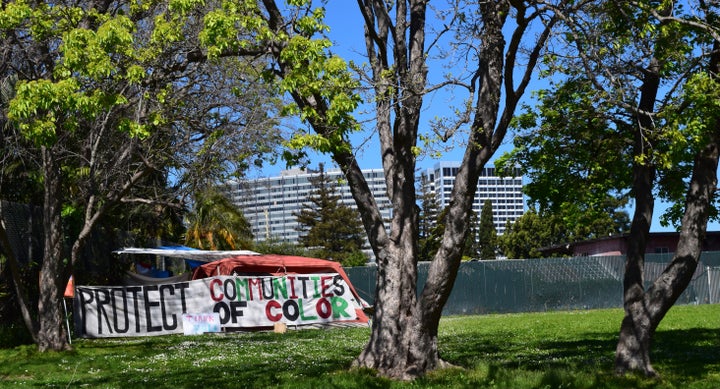
From within the comfortable air-conditioning of a chocolatier in Berkeley, California, I noticed a man sitting on the sidewalk, surrounded by meager possessions and begging for change. I would need to pass in front of him to reach my car. It was the mid-1980s and the country was seizing from Reaganomics.
I drew a breath, put my head down, and with a firm grip on my package walked quickly to my car, ignoring his call for help. When I opened my car door, the man shouted to me.
“You know, you don’t have to give me anything,” he scolded, “but you do have to treat me like a human being.” In that moment I recognized the truth of what he said and saw my own callousness. I spent the rest of the day bouncing between shame and the realization that if my mother were raising us now, our family too would be unable to afford housing.
I was 9 when the burden of being the family breadwinner shifted to my mother. My father had become severely disabled by multiple strokes and my mother, a woman without a high school degree, headed into the labor market to support our family of six. She found a minimum-wage job as a nurse’s aide at a state psychiatric hospital. She chose to work the graveyard shift so that she would be home in the morning to see us off for school and home in the afternoon when we returned. She held that job for many stressful years, yet what I remember most distinctly was the first time I saw her come home from work. I cried all of the way to school, never having seen her so exhausted and demoralized. It was a look I became accustomed to as I grew up.
My mother’s exhaustion soon gave way to a frantic anxiety as she confronted the limits of minimum wage. Her desperation was countered by an incredible strength and determination. She would do whatever she could to keep us fed and to keep a roof over our heads: She stole potatoes and dog food from the grocery store, wrangled soup bones and baloney butts from the local butcher, and more than once sold her blood to area blood banks.
She wept with relief the day my father’s Social Security disability checks arrived. In 1966, my mother earned $1.25 hour — in today’s dollars, that is equivalent to $10.53, or $21,060 per year. It wasn’t enough. It wasn’t enough to pay all of the bills and it wasn’t enough to keep adequate food on the table. If the minimum wage had kept pace with productivity, it would now be over $24 an hour. But it didn’t. The current federal minimum wage is $7.25 an hour ($15,080 a year).

When I took stock of my response to the man on the sidewalk who was begging for change, I realized that all of the people I knew — people who had housing — were responding exactly the same way to the increasing presence of poverty. I began to wonder how we, people whom I knew to be kind and caring, could be so unkind. I began to join people who could not afford housing as they protested emerging laws that criminalized noncriminal behaviors including sitting on the sidewalk and telling lies.
Among the people in this unhoused community was a 55-year-old woman. The small amount of money she had after a hostile divorce had run out and her severe health troubles prevented her from being able to hold a job. She had been on the streets for two years when we met and there didn’t seem to be any way off of them for her. For decades, people fell out of housing when they lost a job or the ability to work. In 2021, the inability to afford housing isn’t just a problem for the unemployed.
While doing research for a new book, I met people across the country, from Appalachia to Oakland, who worked multiple jobs, had multiple roommates and still could not reliably pay all their bills each month. The widening gap between low-wage work and the cost of housing has created a deep crisis for families across the country.
The US Department of Housing and Development (HUD) considers anyone who pays more than 30% of their income on housing to be “cost burdened.” Yet HUD’s own figures show that millions of low-wage families spend between 50% and 70% of their income on housing. HUD has a housing voucher program to help low-income families who are cost burdened by housing. An estimated 9 million families qualify for housing vouchers, but in 2017, when 3 million families were on the federal wait list, the program stopped accepting applications — rendering the safety net virtually meaningless, although housed people seldom know this.
For the rest of my mother’s life, our family lived on the outskirts of a wealthy suburb. The new ZIP code provided an unexpected status and my mother delighted in telling her co-workers that she was a wealthy widow who didn’t actually need to work. She would tell me, “They don’t need to know the truth.” I used to wonder how being “a wealthy widow” protected her at work.
Our family became smaller over the years, first when my father died, and then as the kids grew up. Eventually my mother’s income improved. We celebrated the day she began earning $5.00 an hour like it was a national holiday. Soon, our sheets were no longer stamped “Property of XXX Hospital” and laughter came more easily to all of us. And when my mother began to date, she met a man who helped her to buy a house and things stabilized even more.
That $5.00 an hour might not sound like much to celebrate in 2021, but given the rate of inflation, my mother’s $5.00 an hour would be about $27 an hour ($56,160 per year) in today’s dollars. That reality is breathtaking. Of course, everything is more expensive now: housing, health care, transportation and child care have increased; mobile phones and internet access have become indispensable. So, I wondered how far my mother’s big raise would go today.
I used the Economic Policy Institute (EPI) Family Budget Calculator to determine the basic cost of living for a two-parent, four-child household in Allegheny County (where I grew up) in 2021. It is now almost $100,000. For a two-parent family with two children, the EPI self-sufficiency budget is $79,486. This might make in Allegheny County seem wealthy, and there are wealthy people living there. But the current per capita annual income is $29,549. Millions of working people struggle to keep a roof over their heads and their families fed. In 2019, 44% of all workers held jobs that paid $10.22 an hour or less. And, according to available census data, roughly 51% of workers earn less than $35,000 per year — only slightly above the federal poverty line for a family of four in 2020 of $25,701. As the economy bifurcates between low-wage, low-skilled work, and high-wage, high-skilled work, the nation faces a reckoning that has been decades in the making.

Reaganomics set neoliberal policies in motion that have depressed the minimum wage, displaced middle-class workers, shut down factories, abandoned the working class and cut social safety nets. These same policies have built enormous wealth for corporations and for the top 1%. Among developed nations, the U.S. now has the highest levels of inequality in the world. This should tell you a lot about who the government is serving.
I am decades and thousands of miles from that storefront in Berkeley. What does it mean to treat someone like a human being? That’s a powerful question. We need a national reckoning that squares the stories we tell ourselves about who we are with the reality of the choices we are making.
Celine-Marie Pascale is a professor of sociology at American University in Washington, D.C. She studies how deep inequalities are normalized through the language we use (or don’t use) to describe them. Her newest book, “Living on the Edge: When Hard Times Become A Way of Life,” looks at the lives of people who struggle to make ends meet, a system that profits from their struggles, and a vision for change from the working people who know too well that economy we have is unsustainable for most of the U.S. population. The ebook is available now. You can learn more at cmpascale.org or follow her on Twitter at @cmpascale
Do you have a compelling personal story you’d like to see published on HuffPost? Find out what we’re looking for here and send us a pitch!
